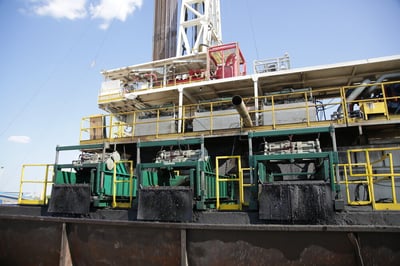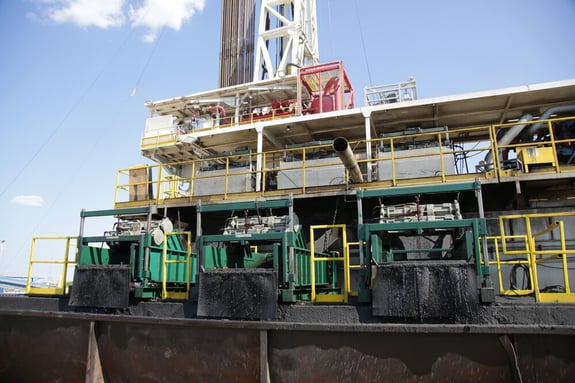 A sound completion fluids design program can result in many benefits for the operator: cleaner drilling mud to help the drilling process, less disposal volume and lower disposal costs, and less wear and tear on the downhole equipment, especially the drill bit. But, by far, the biggest benefit is helping get the well drilled according to plan with the lowest amount of non-productive time. In fact, the right drilling fluids program can reduce days spent drilling the well while lowering overall well costs.
A sound completion fluids design program can result in many benefits for the operator: cleaner drilling mud to help the drilling process, less disposal volume and lower disposal costs, and less wear and tear on the downhole equipment, especially the drill bit. But, by far, the biggest benefit is helping get the well drilled according to plan with the lowest amount of non-productive time. In fact, the right drilling fluids program can reduce days spent drilling the well while lowering overall well costs.
According to one Panther customer, “It is particularly important for the mud system and solids control equipment to keep up with the cuttings to maintain the drilling penetration rates. The last thing I need is to stop drilling and circulate because the solids-control equipment cannot keep up. Panther provided a robust, complete system that did just that. We were able to maintain our aggressive drilling program and finish the well in record time.”
Here are four ways that individual components of a drilling fluids program can help achieve this goal.
-
Minimize excessive fluid volume and higher well costs with less dilution
Smaller particles in drilling mud are more costly to remove. According to DrillingFluid.org, “Our basic aim in solids control is to reduce the formation solids content of a mud to a practical limit that will allow us to maintain the filtration and flow properties in a range to best handle all of the drilling problems. This means that we must pay special attention to control the particles less than (two) microns in size, since they are dominant in determining the mud properties.”
While dilution is a common and effective method of reducing solids in drilling fluid, this option is more costly and inefficient compared to expertly managing the mechanical solids control equipment. Dilution requires extra time spent to mix and add fresh mud to the system and additional time to haul off the excess contaminated mud.
By managing solids mechanically, drilling mud can be used for lengthier periods of time, reducing cost and overall drilling time.
-
Limit high particulate solids in mud that can reduce ROP
It’s no secret that optimizing ROP is key to maintain the drilling plan and reduce total well cost. One Panther customer recently commented, “We are known for pushing the envelope on drilling rates and Panther kept up. Drilling rates were 200 ft per hour in the lateral, with no issues.”
The well’s solids control system must keep up with the drilling plan, and is as important as drill bit selection, weight on bit, rig horsepower and other drilling parameters, in maintaining ROP while drilling. Any number of poorly selected components or lapses in monitoring has potential to significantly reduce ROP.
Ultra-fine size particles affect mud properties adversely because of their large surface-to-volume ratios. According to the article, Solid Control System for Maximizing Drilling, “High particulate solids in the mud reduce ROP because of increase in mud density and viscosity. The higher the mud density, the greater the differential pressure exerts. ROP decreases when differential pressure increases.”
From a fluids perspective, the most effective way to maintain ROP is to limit ultra-fine size particles in mud by mechanically removing and separating the material before it can affect ROP.
-
Maintain drilling rate to meet drilling schedule and AFE
By removing solids before they become a problem (less than two microns in size), operators are able to maintain drilling rates and adhere to drilling schedules. This practice improves drilling efficiency and reduces well construction and fluids disposal costs.
According to PetroWiki, “The combined waste volumes of cuttings that are created while drilling and the excess or spent drilling fluid might be the best measure of performance and cost savings offered by a fluids system.” Concluding, “The volume of spent mud that is created will depend largely on mechanical solids-removal efficiency.”
-
Improve communication and collaboration
Close collaboration between the drilling fluids engineer, solids control expert, and drilling team is imperative to maintaining the drilling plan. Working together, these specialists tune the fluid waste management system to remove the maximum amount of cuttings, recondition the maximum amount of fluid for reuse, ensure the system is working efficiently and keep the well to plan.
Through open communication, limiting dilution and removing solids early, operators can stay on plan and potentially cut time off the drilling program. Depending on well depths and geology encountered together these efficiency savings could reduce overall program time by hours, days or weeks
At Panther Fluids Management, our drilling fluid systems are backed by years of experience and have consistently lowered overall mud costs for clients. We consult with the operator to design the best fluid system for each well; including everything from discrete services like mud and shaker screens to fluids engineering to complex closed-loop systems for solids control to haul-off and disposal via oilfield trucking. We understand the challenges brought on by high temperature and high-pressure formations and can adapt the fluid system to any changes in temperature and pressure that may be encountered while drilling. Contact Panther Companies today for the latest in drilling fluids technology.

